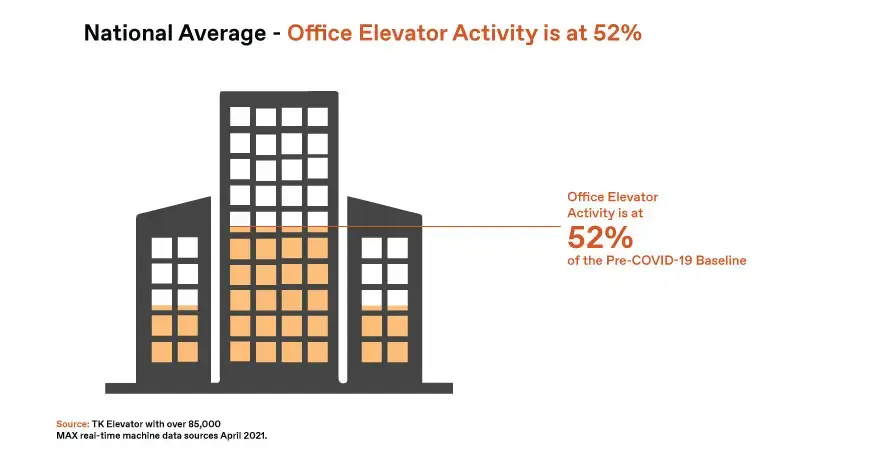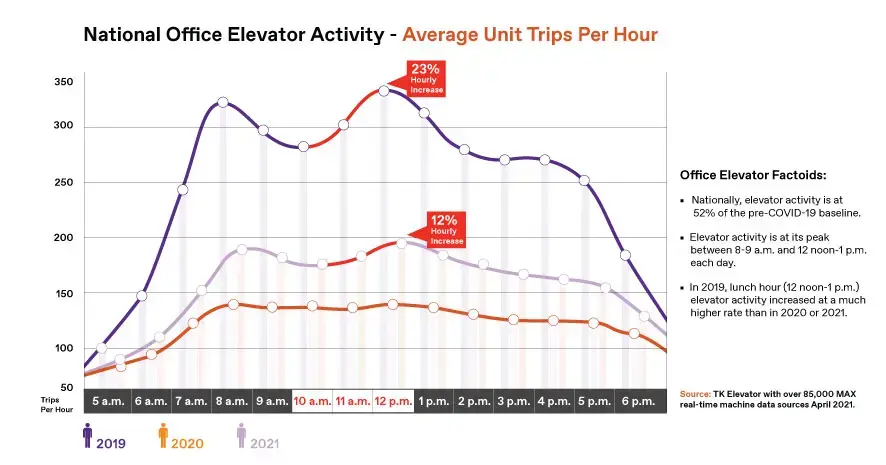What Elevator Data Tells Us About the “New” Office Workday
As we return to post-pandemic normality at work, it’s safe to say that life will be different in many ways. COVID-19 accelerated technological and social change. It transformed how we shop, consume media and now, where and when we choose to work.
Many have theorized the “hybrid” model of work — a mixture of days worked from home and in the office — will change office occupancy. But how? When? What does that mean for building operations, security, facilities managers and even the surrounding public transportation networks? What about retail and hospitality businesses that rely on office workers in the downtown core?
Our TK Elevator Index provides some surprising insights that shine light on what is really happening in commercial buildings across the U.S. We use our MAX real-time machine data to produce the Index. MAX is the elevator industry’s first cloud-based, predictive maintenance solution and is installed on over 85,000 elevators across the country to extract data and provide predictive and proactive service to customers.
Are you coming into the office?
As of May 19, 2021, 65% of respondents to a Morning Consult poll said they would feel comfortable returning to the office. The TK Elevator Index certainly shows a rise in office elevator activity in recent months, but the trends of 2021 differ significantly from the pre-pandemic times in 2019. On a national basis, office elevator activity is at 52% of our pre-COVID-19 baseline.

In 2021, like the “before” times of 2019, we follow a similar crescendo of heavy elevator activity from 7-9 a.m. Then we seem to settle down on one floor of the building to get some work done from 9-10 a.m. From 10 a.m.-12 noon, we then see a steady increase in elevator activity as people head off for midday meetings and eventually lunch from 12 noon-1 p.m.
We can tell by the high elevator activity around 12 noon in 2019, that “lunch” used to be someplace else. We used to get away from our desk, get food off-site or even downstairs in the office café to grab a bite to eat, enjoy some fresh air and a change of scenery.
What is different in 2021, is less of us are taking that midday elevator trip from 12 noon-1 p.m. In April 2019, there was a 23% increase in elevator activity between 11 a.m.-12 noon versus 12 noon-1 p.m. During that same late-morning period in 2021, there was only a 12% increase in elevator activity.

We can speculate that people coming into the office these days are more likely to bring their own lunch and not travel to surrounding restaurants, cafes and retail for midday errands. It’s too early to tell if this is a long-term trend or short-term blip on the radar, but it could be a concern for businesses relying on commuters for revenue in the cores of major U.S. cities.
There could be any number of reasons for this. Some people may be slammed with video calls and can’t get away. Or maybe they don’t want to take the perceived health risk to go out in public in the middle of the workday? There could be a multitude of reasons why the “lunch hour” has declined.
Our TK Elevator Index data powered by MAX is showing two clear trends. First, more people are coming back to office each month since early in 2021. Secondly, our use of the office is changing. This raises important questions about office design, facility management policies and urban planning. We are looking forward to working with our clients to help them plan more effectively for a post-pandemic future.
 United States
United States

